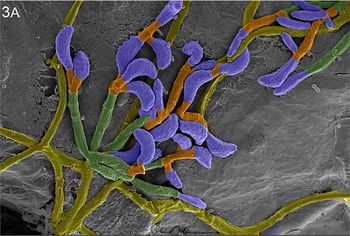Catonella morbi
A Microbial Biorealm page on the genus Catonella morbi
Classification
Higher order taxa
Bacteria; Firmicutes; Clostridia; Clostridiales; Lachnospiraceae
Species
Catonella morbi
Description and significance
Catonella morbi is a gram negative staining bacillus, or rod shaped cell, isolated from human gingival crevices. These crevices are located between the soft tissue of the gums and the hard enamel of the teeth. It was first recognized and isolated in 1985 at the Anaerobe lab of the Virginia Polytechnic Institute and State University [6]. The type strain was later isolated, cultured, and described by Moore and Moore for the first time in 1994 [1]. The genus Catonella is named in honor of Elizabeth Cato, as she was the first to isolate this microorganism at the Virginia Polytechnic lab[1]. At this time, Catonella morbi is the only species within this genus categorization. This microbe is of particular importance due to its human host relationship and is found exclusively in humans thus far. Current study is being done on its role in the cause of periodontitis and endocarditis.
Genome structure
This species is part of the human microbiome project. The genome of the type strain ATCC 51271 was sequenced completely in March of 2009[4]. C morbi has a relatively small genome of approximately 2.0 Mbp or 2,042,370 base pairs. The genome was constructed from three sequencing contigs. This sequence consists of 1348 functional proteins and 466 hypothetical proteins [4]. It is unique among other gram negative anaerobic rods by its relatively low G and C DNA composition of 34% [1]. These genetic characteristics along with its fermentation products place it as the only species within the Catonella genus at this time [6].
Cell and colony structure
In culture, this organism occurs in pairs and short chains. Cells are observed to be 0.7-1.0µm wide and 1.6-4.0µm long. In some cultures, cells have been observed to show a central swelling [2]. This microbe is not known to be motile [3]. C morbi are gram negative staining, indicating a cell envelope that includes a thin peptidoglycan layer and an outer lipopolysaccharide outer membrane. In one isolate, cells were observed to be pleomorphic, meaning that the cells were capable of altering their shape and size based on the environment. In this case, both the gram negative bacilli and gram variable staining diplococcic were present in the smear [2]. On blood agar incubated at 37 degrees Celsius for two days, colonies are approximately 1mm in diameter, convex, and opaque, white in color [1].
Metabolism
This microbe is strictly anaerobic and goes through saccharolytic fermentation. In environments where no oxygen and an adequate amount of glucose is present, it is known to produce acetic acid, formic acid, and lactic acid. It is unique among other sacchrolytic rods by this acetic acid product [1]. C morbi is also capable of fermenting dextrin, lactose, and maltose. In a single isolate, the organism was sited to be negative for oxidase and catalase [2]. On Rabbit blood agar, no hemolytic properties were observed [3].
Ecology
This organism has solely been isolated from gingival crevices of humans at this time. C. morbi thrives in mesophilic temperatures, 37 degrees Celsius, the same temperature as its human host [1].
Pathology
As of this time, Catonella morbi has only been isolated from humans, specifically from the oral cavity. No other host has yet been found. It has been cited to be one of many bacteria behind endodontic infections and periodontitis [5]. Periodontitis is described as the inflammation of the gums and the soft tissue surrounding the teeth. In severe cases, the gums can begin to recede, resulting in loosening of the teeth and more serious complications such as loss of teeth[4]. In one study, this microbe has been cited to be the cause of native valve endocarditis, a heart disease involving inflammation of the endocardium [2]. These type of infections can often result from microbes residing in the oral cavity, as the mouth is an opportune location for bacteria to enter the blood. C. morbi is susceptible to a number of antibiotics, such as chloramphenicol, clindamycin, erythromycin, penicillin, and tetracycline [1]. Any of these antibiotics may be prescribed in the treatment of periodontitis or as a preventative measure in immunocompromised patients undergoing dental work [5].
References
[1]. [Bergey, David Hendricks, Paul De Vos, and William Barny Whitman. The Firmicutes. Dordrecht: Springer, 2009. Print.]
[2]. [Menon, T and Naveen Kumar, V. Catonella morbi as a cause of native valve endocarditis in Chennai, India. Infection. February 2012;40;581-582.]
[3]. [Moore LVH, Moore WEC. Oribaculum catoniae gen. nov., sp. nov.; Catonella morbi gen. nov., sp. nov.; Hallella seregens gen. nov., sp. nov.; Johnsonella ignava gen. nov., sp. nov.; and Dialister pneumosintes gen. nov., comb. nov., nom. rev., Anaerobic gram-negative bacilli from the human gingival crevice. Int J Syst Bacteriol. 1994;44:187–92.]
[4]. ["PATRIC::Catonella Morbi ATCC 51271::Genome Overview." PATRIC::Catonella Morbi ATCC 51271::Genome Overview. N.p., n.d. Web. 11 Dec. 2015.]
[5]. [Siqueira JF Jr, Roˆc¸as IN. Catonella morbi and Granulicatella adiacens: new species in endodontic infections. Oral Surg Oral Med Oral Pathol Oral Radiol Endod. 2006;102:259–64.]
[6]. [Willems A, Collins MD. Evidence for the placement of the gramnegative Catonella morbi (Moore and Moore) and Johnsonella ignava (Moore and Moore) within the Clostridium subphylum of the gram-positive bacteria on the basis of 16S rRNA sequences. Int J Syst Bacteriol. 1995;45:855–7.] rovide the DOI number for articles. For example:
Edited by Kimberly Mills of Dr. Lisa R. Moore, University of Southern Maine, Department of Biological Sciences, http://www.usm.maine.edu/bio

